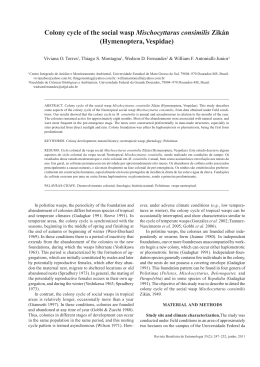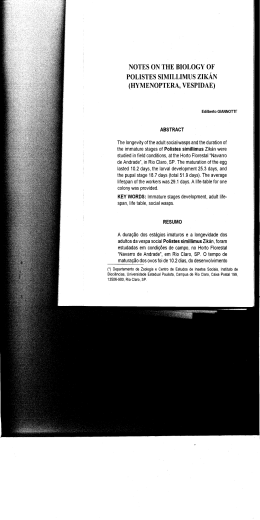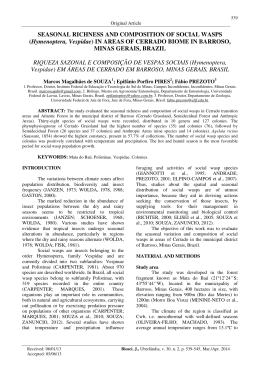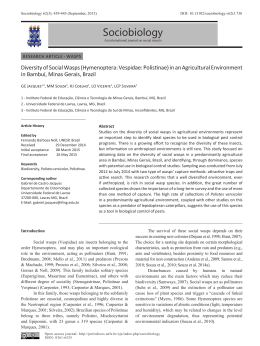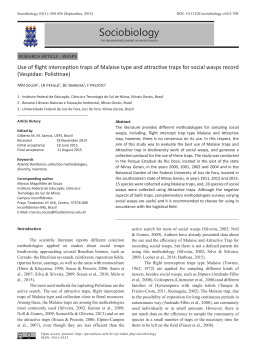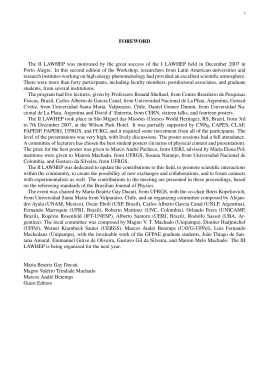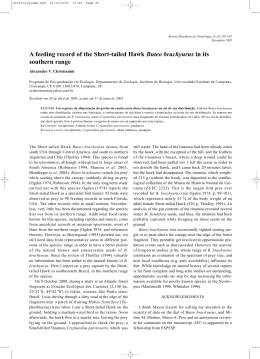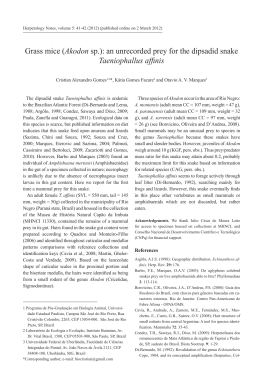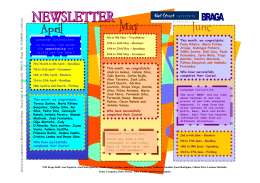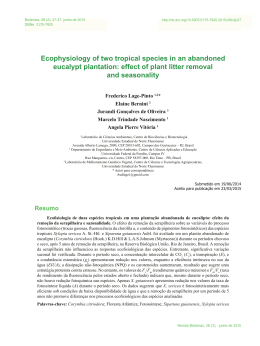61 Foraging Behavior of the Swarm-Founding Wasp, Polybia (Trichothorax) sericea (Hymenoptera, Vespidae): Prey Capture and Load Capacity by Carlos Costa Bichara Filho1, Gilberto M. de M. Santos1,2, Janete Jane Resende2, Jucelho Dantas da Cruz1,2, Nivar Gobbi3 & Vera Ligia L. Machado3 ABSTRACT The main component of the protein diet of P. sericea was larvae of Lepidoptera (75.38 %), with predominance of the following Families: Noctuidae (30.99 %), Hesperiidae (19.01 %); Pyralidae (19.01 %) and Nymphalidae (11.98%). The average weight of the prey captured was 14.2 mg, a value equivalent to 24.7 % of the average wasp weight. The average glucidic food load was 28.61 mg, corresponding to approximately half the wasp weight (49.64%). The weight of the load transported in the crop varied according to the food density, which, in turn, influenced the time spent in its collection (Pearson: n= 64; r= 0.64; p<0.05). Polybia sericea showed predatory interactions against Lepidopteran caterpillars, who are known to be agricultural pests. P. sericea has potential to be used in Integrated Pest Management. Keywords: social wasps, Polistinae, biological control, prey. INTRODUCTION An important review of social wasp foraging behavior, carried out by Raveret-Richter (2000), evidenced a great variability in the strategies to collect water, prey, and carbohydrate used by these wasps, both within the same and in different species. The swarm-founding wasps' diet is extremely assorted: nectar, fruit juices, honeydew, and sugary human food are the basis of the adult diet (Evans & West-Eberhard 1970; Hunt et al. 1987), being also important sources of energy for wasps in their early stage of development (Akre et al. 1980). Lepidoptera larvae are the main source of protein Laboratório de Entomologia, Departamento de Ciências Biológicas, Universidade Estadual de Feira de Santana, 44.031-460, Feira de Santana, Bahia, Brazil. Email: [email protected] 2 Programa de Pós Graduação em Zoologia Universidade Estadual de Feira de Santana 3 Instituto de Biociências - Depto. de Ecologia - UNESP, 13.506-900, Rio Claro - SP, Brasil 1 62 Sociobiology Vol. 53, No. 1, 2009 for social wasps in their early developmental stages (Evans & West-Eberhard 1970), but their diet may also include vertebrate and invertebrate carcasses, Anura eggs and tadpoles, human food, and a large variety of small arthropods (Raveret-Richter 2000). The opportunistic behavior of the social wasps impels them to hunt the most abundant resources available in the environment. Therefore, like other generalist predators, they contribute to the control of populations of several pests insects (Marques 1989). Despite their potential to reduce agricultural pest populations in biological control programs (Martin & Arias 1983; Prezoto 1999), the use of social wasps as biological controllers of pests is still fairly uncommon. Knowledge of several aspects of wasp behavior and ecology, such as the effect of agricultural pesticides on wasps (Hebling-Beraldo et al. 1982; Picanço et. al 1998; Santana-Reis et al. 2002; Santos et al. 2003), flight capacity (Gobbi 1978; Santos et al. 1994 2000), daily activity (Andrade & Prezoto 2001; Resende et al. 2001), diet (Gobbi et al. 1984; Gobbi & Machado 1985 1986; Machado et al. 1987,1988; Prezoto et al. 1994) and load-carrying capacity (Malaspina et al. 1991) is required to use social wasps in integrated pest management systems. In this work, we aimed to determine the loadcarrying capacity and identify the prey captured by Polybia (Trichothorax) sericea (Olivier). MATERIAL & METHODS Area of study The study was carried out at the Campus of the Universidade Estadual de Feira de Santana, placed in the municipality of Feira de Santana (12º 16'S; 38º 58'W), State of Bahia, Brazil. This area is inserted in the vegetation of the “Caatinga,” a kind of dry and deciduous shrubby vegetation. The climate in this region is dry to subhumid, with an annual average of 867 mm of rain. Data collection and analysis From June 2000 to April 2001, we followed a colony of P. sericea from colony-founding until declination and nest abandonment. In order to evaluate their diet, twenty wasps were captured every week when returning to the nest with their prey. We weighed the captured prey using an analytical digital balance (Sartorius VP221S), with 0.00001g precision to calculate P. Bichara Filho, C.C. et al. — Foraging Behavior of Polybia sericea 63 sericea capacity to carry prey. The captured prey were kept in ethanol and were identified later. The high degree of fragmentation of some samples made it impossible to identify the prey to a lower taxonomic level. The Dice similarity coefficient was used to compare the diets of wasp species from different places with the diet found in this study for P. sericea. The capacity to carry glucidic food was determined according to a methodology developed by Neves-Fermiano & Stort (1985) for bees, later adapted by Malaspina et al (1990) for Polybia paulista (Iehring, 1896). Our study on glucidic food-carrying capacity was performed using wasps from three colonies. Wasps were trained to collect a glucose syrup (maize-syrup) solution in a container placed on the weighing tray of a Sartorius VP221S analytical digital balance with 0.00001g precision, placed about 2.5 m from the nest. We offered sugary solution in three different proportions of maize-syrup/water (1.3/1, 1.4/1 and 1.5/1). Time spent to collect glucidic food and the weight of the food collected by each wasp were recorded. We estimated the volume collected in each trip based on the weight recorded, in order to evaluate the fluid food-carrying capacity of P. sericea. To identify the existence or absence of a significant difference in the load capacity between the colonies, the Kruskal-Wallis non-parametric test for average comparison was used. Pearson Linear Correlation was used, to check for correlation between the measured variables (weight of the wasp, of their prey, of the glucidic food, time spent to collect the food and concentration of the sugary solution). RESULTS & DISCUSSION Most of the material collected by P. sericea was composed of macerated and/or fragmented bodies of prey, thus making it impossible to identify them at lower levels. Three hundred and twenty one samples of materials transported by the workers of P. sericea were collected. Two hundred and forty nine samples were insects and they were identified to the Order level. We recorded an unquestionable preference for larvae of Lepidoptera (242 samples), corresponding to 75.38 % of the total number of samples. From the total amount of captured Lepidopterans, 77.68 % were identified to the Family level; and we recognized the species of prey in 7.44 % of the samples. The following species were identified: Alabama argillacea, Spodoptera 64 Sociobiology Vol. 53, No. 1, 2009 Table 1. Prey captured by foragers of Polybia sericea in Feira de Santana, Bahia State, Brazil. June 2000 to April 2001. LIST OF PREY MATERIAL CAPTURED (N) Juvenile forms Adult insects Macerated prey FREQUENCY (%) Hymenoptera 1 - - 0.31 Diptera 1 - - 0.31 Coleoptera 3 - - 0.93 Homoptera - 1 - 0.31 Heteroptera 1 - - 0.31 Lepidoptera 206 - 36 75.40 Family Arctidae 1 - - - Family Cythernidae 1 - - - Family Geometridae 4 - - - Family Hesperiidae 46 - - - Family Noctuidae 75 - - - Family Nynfalidae 29 - - - Family Olethrentidae 1 - - - Familia Pyralidae 46 - - - Family Saturnidae 3 - - - - 36 - Family not identified - Other unidentified material 23 1 48 22.43 TOTAL 235 2 84 100 Bichara Filho, C.C. et al. — Foraging Behavior of Polybia sericea 65 fugiperda, Elasmopalpos lignosellus, Pseudoplusia includens, and Chlosynelacinia saundersii. Noctuidae (30.99 %), Hesperiidae (19.01%); Pyralidae (19.01%) and Nymphalidae (11.98%) were the most frequent families in the samples (Table 1). Hesperiidae was the most consistently found family during the whole study, being present in all months of sampling; however, it was captured frequently only in the absence of other Lepidopteran families (Fig.1). P. sericea showed replacement of prey during the study, corroborating the generalist and opportunist behavior of this species, who tended to hunt the more abundant prey. The constant presence and the high frequency of Lepidoptera larvae indicated a high hunting pressure exerted by social wasps on this group; during the study, it was common to see a repeated capture of the same prey species. Similar results were obtained for other species, such as P. occidentalis occidentalis (Gobbi et al. 1984), P. paulista (Gobbi & Machado 1985; P. ignobilis (Gobbi & Machado 1986), Agelaia pallipes (Machado et al. 1987), Polistes simillimus (Prezoto et al. 1994), P. fastidiosuscula (Tech 1987), Polistes lanio (Giannotti et al. 1995) and Polistes versicolor (Prezoto et al. 2006). All these works evidenced the importance of Lepidopterans in the diet of social wasps. Fig. 1. Monthly changes in the abundance of the main prey families captured by Polybia sericea in Feira de Santana, Bahia State, Brazil. June 2000 to April 2001. 66 Sociobiology Vol. 53, No. 1, 2009 The similarity analysis showed that the diet of Polybia sericea in Rio Claro (São Paulo State, Southest Brazil) is closer to that of other wasp species from the same region (Polybia ignobilis and Agelaia pallipes) than to the diet of P. sericea from Feira de Santana (Bahia State, Northeast Brazil) (Fig. 2). This means that the hunted species vary considerably from place to place, and that wasps hunt the most abundant prey more frequently. These data corroborate the facultative specialist behavior of the social wasp foragers. According to Raveret-Richter (1990, 2000), “individual social wasp foragers often return to hunt in sites of previous hunting success and may feed repeatedly on same species of prey, thus acting individually as facultative specialists.” Some studies performed under natural and controlled conditions have shown that social wasps develop strategies to maximize their hunting efficiency, including strategies against defense mechanisms of caterpillars (Marques et al. 2005; Raveret-Richter 1990). Polybia sericea behavior related to hunting strategies, location, manipulation, and protection of hunted prey against other predators were described by Raveret-Richter & Jeanne (1985, 1991). In our study, the weight of the wasps ranged from 42.7 mg to 73.6 mg (average of 59.0 mg), while the weight of the transported prey ranged from 1.9 mg to 32.5 mg (average of 14.2 mg). Thus, these wasps can carry prey whose average weight is equivalent to 24.7 % of their own weight. P. sericea Fig. 2. A - Similarity in the diet of Agelaia pallipes, Polybia ignobilis and Polybia sericea from Rio Claro (São Paulo State, Brazil). B - Similarity in the diet of Polybia sericea from two different places in Brazil (Rio Claro, São Paulo State and Feira de Santana, Bahia State). Bichara Filho, C.C. et al. — Foraging Behavior of Polybia sericea 67 showed a prey-carrying capacity higher than Polybia paulista, which can transport prey weighting the equivalent of 7.1 % of its weight (Malaspina et al. 1990). Our data agree with previous studies that estimated the protein load transported to the nest by both P. sericea (522.6 mg/day, Machado et al. 1988) and P. paulista (108.9 mg/day, Gobbi & Machado 1985). The load of glucidic food transported by P. sericea ranged from 19.11 mg to 22.63 mg (average weight of 28.61 mg). The average weight of that load corresponded to approximately half of the weight of an average wasp (49.64 %). Similar results were obtained for Polybia paulista and Polybia ignobilis, which had fluid load carrying capacities of 47.7 % and 53.5 % of their weight, respectively (Malaspina et al. 1990, 1991). These authors emphasized that crop volume is a limiting factor in the capacity of carrying fluid food. We found a significant difference in the average weight of food collected by wasps from the three different densities of the sugary solution tested (KruskalWallis Non-parametric test, p<0.05). The time spent collecting food ranged from 24 to 358 seconds (average of 135.25 seconds). The density of the solution influenced the time spent in the collection: food collection demanded more time when the density increased (Pearson Correlation matrices: n= 64; r= 0.64; p<0.05). Our study shows that Polybia sericea has strong predatory interactions against Lepidopteran caterpillars, which are prominent agricultural pests. Therefore, P. sericea has the potential to be used in integrated pest management, helping in the maintenance of the equilibrium of the agroecosystems. REFERENCES Andrade, F.R. & F. Prezoto 2001. Horários de atividade forrageadora e material coletado por Polistes ferreri Saussure, 1853 (Hymenoptera: Vespidae), nas diferentes fases do seu ciclo biológico. Revista Brasileira de Zoociências 3(1):117-128. DeBach, P. 1951. The necessity for an ecological approach to pest control on citrus in California. Journal of Economic Entomology, Lanham 44:443-447. Evans, H. E. & M.J. West-Eberhard 1970. The Wasps. Ann Arbor: University of Michigan Press 1970. 265p. Giannotti, E., F. Prezoto & V.L.L. Machado. 1995. Foraging activity of Polistes lanio lanio (Fabr.) (Hymenoptera: Vespidae). Anais da Sociedade Entomológica do Brasil 24: 455-463. Gobbi, N. 1978. Determinação do raio de vôo de operárias de P. versicolor (Hymenoptera: Vespidae). Ciência e Cultura 30(7) Suplemento:364-365. 68 Sociobiology Vol. 53, No. 1, 2009 Gobbi, N. & V.L.L. Machado 1985. Material capturado e utilizado na alimentação de Polybia (Myrapetra) paulista Ihering, 1896 (Hymenoptera - Vespidae). Anais da Sociedade Entomológica do. Brasil 14(2):189-195. Gobbi, N. & V.L.L. Machado 1986. Material capturado e utilizado na alimentação de Polybia (Trichothorax) ignobilis (Haliday, 1836) (Hymenoptera, Vespidae). Anais da Sociedade Entomológica do Brasil 15(Suplemento):118-124. Gobbi, N., V.L.L. Machado & J.A. Tavares Filho 1984. Sazonalidade das presas utilizadas na alimentação de Polybia occidentalis occidentalis (Olivier, 1791) (Hym., Vespidae). Anais da Sociedade Entomológica do Brasil 13(1):63-69. Hebling-Beraldo, M.J.A., E.A. Rocha & V.L.L. Machado. 1982. Toxidade de inseticidas (em laboratório) para Polybia (Myrapetra) paulista (Ihering, 1896) (Hymenoptera: Vespidae). Anais da Sociedade Entomológica do Brasil 10: 261-267. Machado, V.L.L., N. Gobbi & D. Simões 1987. Material capturado e utilizado na alimentação de Stelopolybia pallipes (Olivier, 1791) (Hymenoptera - Vespidae). Anais da Sociedade Entomológica do Brasil 16(1):73-79. Machado, V.L.L., N. Gobbi & V.V. Alves Junior 1988. Material capturado e utilizado na alimentação de Polybia (trichothorax) sericea (Olivier, 1791) (Hymenoptera, Vespidae). Revista Brasileira de Zoologia 5(2):261-266. Malaspina, O., N. Gobbi & V.L.L. Machado 1990. Capacidade de transporte de alimento em operárias de Polybia (Myrapetra) paulista Ihering, 1896 (Hymenoptera, Vespidae). Anais da Sociedade Entomológica do Brasil 19(2):457-463. Malaspina, O., N. Gobbi & V.L.L. Machado 1991. Capacidade de transporte de alimento de Polybia (Trichothorax) ignobilis (Haliday 1936 (Hymenoptera, Vespidae). Anais da Sociedade Entomológica do Brasil 20(1):169-173. Marques, O. M. ; C.A.L. de Carvalho, G. M. de M. Santos & C.C. Bichara Filho 2005. Defensive Behavior of Caterpillars of Heraclides anchysiades capys (Lepidoptera: Papilionidae) Against the Social Wasp Polistes versicolor versicolor (Hymenoptera:Vespidae). Magistra 17:28-32. Martin, C. A. & B. Arias 1983. Método de recoleccion, transporte y establecimento de Polistes erythrocephalus. In: Martin, C. A. (Comp.). Programa de Yuca: Control Integrado de plagas, Cali, Colombia, PNUD/CIAT, p.353-358. Neves-Fermiano, L.H.M. & A.C. Stort 1985 Study of food gathering behavior in Italian bees, in Africanized bees, and in the descendents of the crossings. Revista Brasileira de Genética 8(1):26-36. Picanço, M., L.J. Ribeiro, G.L.D. Leite & M.R. Gusmão. 1998. Seletividade de inseticidas a Polybia ignobilis (Haliday) (Hymenoptera: Vespidae) predador de Ascia monuste orseis (Godart) (Lepidoptera: Pieridae). Anais da Sociedade Entomológica do Brasil 27: 85-90. Prezoto, F. 1999. Vespas: a importância das vespas no controle biológico de pragas. Biotecnologia 11(9):24-26. Bichara Filho, C.C. et al. — Foraging Behavior of Polybia sericea 69 Prezoto, F., Giannotti, E., Machado, V.L L. 1994. Atividade forrageadora e material coletado pela vespa Polistes simillimus Zikán 1951 (Hymenoptera, Vespidae). Insecta 3(1):1119. Prezoto, F., H.H. Santos-Prezoto, V.L.L. Machado & J.C. Zanuncio. 2006. Prey captured and used in Polistes versicolor (Olivier) (Hymenoptera: Vespidae) Nourishment. Neotropical Entomology 35(5):707-709. Resende, J.J.,Santos, G.M. de M., Bichara Filho, C.C., Gimenes, M. 2001. Atividade de busca de recursos pela vespa social Polybia occidentalis occidentalis (Olivier, 1791) (Hymenoptera, Vespidae). Revista brasileira de Zoociências 3(1):105-115. Raveret-Richter, M. 1990. Hunting Social Wasp Interactions: Influence of Prey Size, Arrival Order, and Wasp Species. Ecology 71(3):1018-1030. Raveret-Richter, M. 2000. Social wasp (Hymenoptera:Vespidae) foraging behavior source. Annual Review of Entomology 45:121-150. Raveret-Richter, M.A. & R.L. Jeanne. 1991. Hunting behavior, prey capture and ant avoidance in the tropical social wasp Polybia sericea (Hymenoptera: Vespidae). Insectes Sociaux 38(2):139-147. Raveret-Richter, M.A. & R.L. Jeanne. 1985. Predatory behavior of Polybia sericea (Olivier), a tropical social wasp (Hymenoptera: Vespidae). Behavioral Ecology and Sociobiology 16(2):165-170. Santana-Reis, V.P.G. ; O.M. Marques & J.A. Costa 2002 . Seletividade de inseticidas ao predador Polistes canadensis canadensis (L., 1758) (Hymenoptera-Vespidae). Acta Biologica Leopoldensia 24(2):141-146. Santos, G. M. de M., O.M. Marques & C.A.L. de Carvalho 1994. Raio de ação de Polistes canadensis canadensis (L., 1758) (Hymenoptera, Vespidae). Insecta 3(2):20-24. Santos, G.M. de M., V.P.G. Santana-Reis, J.J. Resende, P. D’Marco & C.C. Bichara Filho 2000. Flyng Capacity of swarm-founding wasps Polybia occidentalis occidentalis (Olivier, 1791) (Hymenoptera, Vespidae). Revista brasileira de Zoociências 2(2):33-39. Santos, L.P., J.J. Resesende; G.M. de M. Santos, C.C. Bichara Filho & V. P. G. Santana-Reis 2003. Seletividade de inseticidas a Polybia (Trichothorax) sericea (Olivier, 1791)(Hymenoptera, Vespidae) em condições de laboratório. Revista brásileira de Zoociências,5(1):33-44.
Download
